
Before the hydraulic system works, the oil tank shall be filled with a certain amount of hydraulic oil, and the accumulator shall be filled with 5MPa nitrogen. When pressing oil into the hydraulic system for the first time (or starting again after the oil is drained from the system), the air release valve should be opened first, and the manual reversing valve should be at the oil feeding position, then the hydraulic pump should be started to press oil into the system, which is to remove the residual air in the system.
Because there is air in the hydraulic system, it will cause the moving cone to vibrate up and down when the machine is working, so that the size of the ore discharge mouth will fluctuate, and related parts will be worn. When the exhaust valve emits oil, it indicates that the air has been exhausted. Close the exhaust valve and continue to pressure oil into the system.

The moving cone rises slowly under a certain pressure (generally less than 1MPa), while the oil level in the oil tank drops slowly. When the moving cone rises to contact with the fixed cone, the oil feeding shall be stopped immediately, and the manual reversing valve shall be in the middle position. At this time, the oil level of the oil tank can be used as the zero position of the ore drain gauge. Then place the manual reversing valve in the return position. The oil in the reaction crusher system returns to the oil tank under the gravity of the moving cone, the oil level in the oil tank rises, and the moving cone drops. The size of the ore discharge opening can be read directly on the ore discharge opening ruler according to the change of oil level in the oil tank.